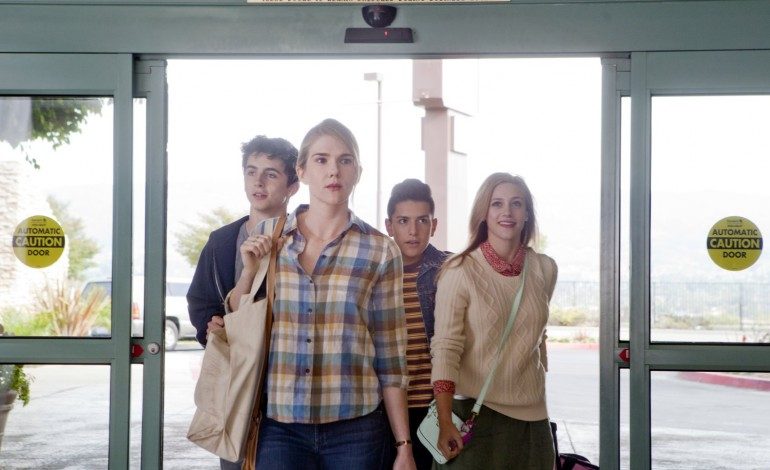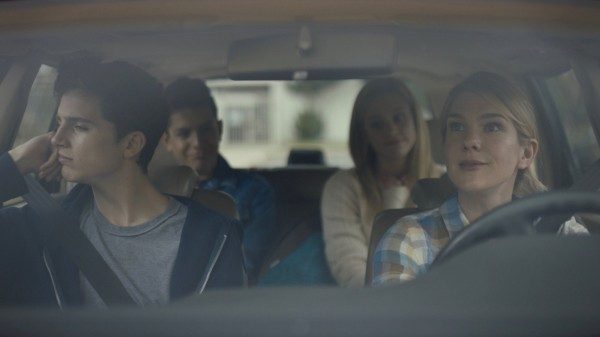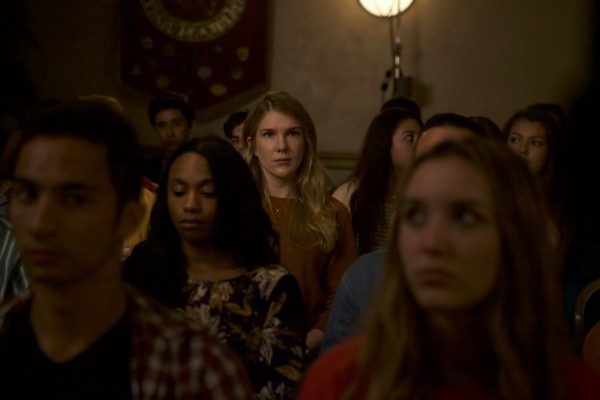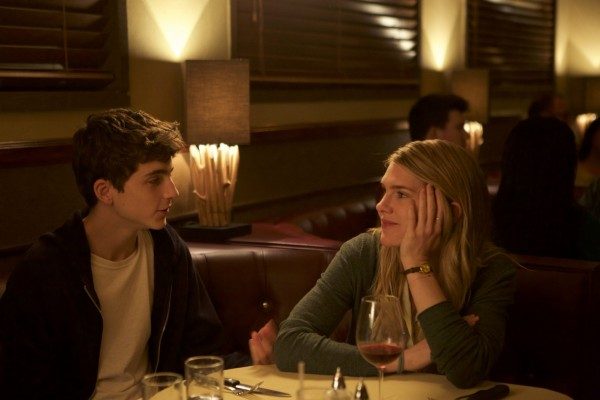

Everyone, in one form or another, has encountered the idiom “we put on a mask to face the day”. In Julia Hart’s Miss Stevens, she explores this idea on multiple levels, from a literal translation of theater and putting on a performance or character, to incarnations in everyday life, such as between a teacher and her pupils. Hart’s story reveals the beautiful yin and yang of figurative mask-wearing, from its therapeutic applications, its ability to hide our true selves, or its upholding of boundaries. What seems like a simple story of grief and a teacher’s emotional outpouring during the most inopportune time, – as a chaperone to a student field trip – turns into something quite profound through Hart’s intricate blend of the cinematic and mundane and her depth of characters from Miss Stevens herself, to each student following her every move.
Miss Stevens follows the eponymous Rachel (Lily Rabe, TV’s American Horror Story), a high school English teacher who has volunteered to take three students to a weekend acting camp/competition. In tow she has Margot (Lili Reinhart, Kings of Summer), a type-A honors student who has planned the trip herself, Sam (Anthony Quintal), a flamboyant and gregarious theater junkie, and Billy (Timothée Chalamet, Interstellar), an intelligent, but troubled acting prodigy dealing with known depression and general indifference. Rachel herself is grieving from the recent death of her mother, and Billy quickly latches onto Miss Stevens’ shared underlying sadness. The series of events follows the mismatched group as their boundaries fade – much to Rachel’s dismay and protestation – and they see behind one another’s masks, uncovering emotional baggage and insecurities.
Everyone in the group is acting in one way or another, which can’t help but bring to mind Macbeth’s famous musings about life reflecting a poor player upon the stage, being “full of sound and fury, signifying nothing”. The difference here is that Hart gives audiences hope and a silver lining. Margot acts the part of the perfectionist, needing to excel at everything she does, but reeling from the truth that she is not a natural thespian. Sam, the most straightforward and identity-secure of the bunch, is the literal actor, taking the craft most seriously.
Billy is a little trickier of a character, while being the most talented, he lives his performances and tries to run away from the acting forced upon him by medications. Miss Stevens, Billy’s foil, was a former actress in her younger years and has taken up acting professionally as a teacher without realizing it. She mentions early on to her class that school is a place where we feel at times we cannot be our true selves, and also later tells the kids (after blowing out a tire and rounding off a series of curse words) that her perfect teacher behavior is a switch she turns on and off.
Hart uses this idea of acting in everyday life to further explore the often forced and sensitive student-teacher dynamic. Where this could land Hart into cliche female teacher, male student territory, the filmmaker instead uses the plot device wisely to dive deeper into Rachel’s psyche and the deep hurt she is feeling inside. While Billy has an inappropriate crush on his teacher, it is somewhat founded on the recognition of her sadness within himself. Rachel fends him off admirably for the most part, and his and Rachel’s connection is ultimately understandable. Still experiencing feelings of loss and abandonment from her mother, – also a former actress – Rachel is in a sort of suspended childlike state, continuing to yearn for that parental connection. Rabe pulls this off expertly, transitioning at a moment’s notice between unconscious youthful vulnerability and forced cognizant maturity.
Hart also puts a lot of effort in telling Rachel’s story through her visuals. She is able to capture an interesting blend of cinematic wonder and day-to-day banality through contrasting scenes. The first shot is one of Rachel after a theater production, alone in the stadium seats looking at the empty stage and beginning to cry. The spotlight, however, is on her, as if she is the one putting on the performance. The majority of the film, though, is shot in either oppressively bright day shots, or oppressively hazy interior scenes, like those in their budget hotel rooms. When the characters aren’t glowing under the spotlight-esque lighting, they are squirming under phosphorescence (of both the outdoor and indoor variety), creating a sort of fabricated environment that is no more real than the stage.
Verdict: 4 out of 5
Miss Stevens is in the very least a new and unique perspective on both grief and student-teacher relationships. Hart takes her film so much further though, showing a parallel between the role of the teacher and performing in front of an audience. Hart also spreads the narrative love to all of her subjects, using them as viable representations of this Shakespearean dynamic between life and acting. All three young actors do incredible work opposite Rabe, showing emotional maturity while also embodying the youth of their characters. If there is a single thing to nitpick, the visuals, while thematically pleasing, do tend to be a bit of an eyesore. That aside, however, Miss Stevens is indie filmmaking at its finest and is a story that is beautifully executed by both its filmmaker and actors.



